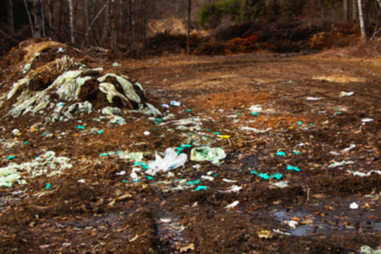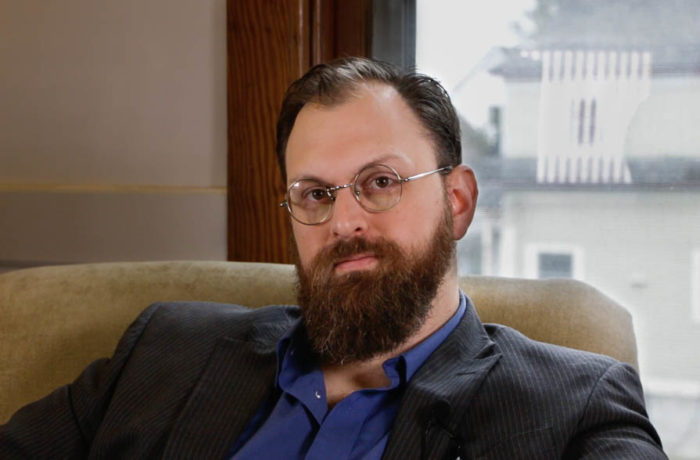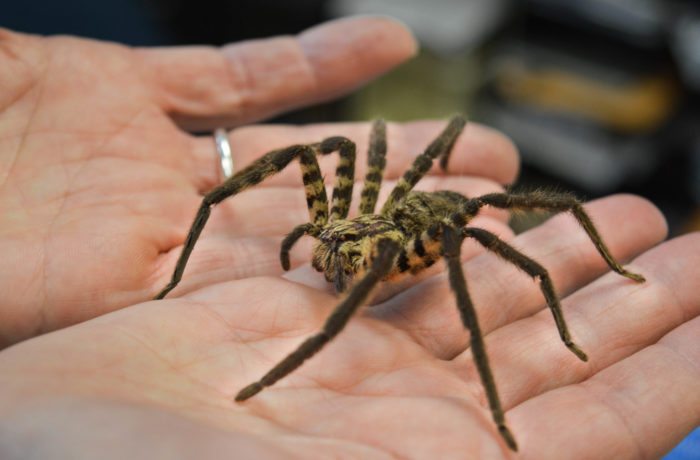By Audrey Sinclair
Last year, when I saw the eye-popping image online of a person who’s managed to fit their whole year’s worth of trash in one single jar, it sparked something in me. It seemed almost unreal. While very few, if any, of us may ever eliminate all of our waste, like the zero waste bloggers grinning to the camera about how they’ve managed to remove all disposable items and other garbage from their lives, the movement is about much more than that. What is important is that we reassess how much waste we all produce and feel inspired to reduce that amount. I wanted to give it a try for myself, even if I just started small.
Americans produced roughly 258 million tons of waste in 2014, with 136 million tons ending up in a landfill, according to the EPA. That’s almost four and a half pounds of trash, per person, per day. Think of all the uneaten or expired food you toss out, how much packaging you discard to get to the items you purchased, and how many convenient single-use items like paper coffee cups or paper towels you throw in the trash when you’re done with them. It all adds up when you multiply your personal waste by the number of days in a year and the millions of people who live in the country.
I thought instantly eliminating all of the waste from my lifestyle sounded too difficult, and I believe I’m right. It’s not something I can do instantaneously. The key is to begin with small steps and build from there.

Audrey Sinclair saved her waste that I would have put into a trash or recycling dumpster from Monday morning to Friday evening. It totaled 131 pieces.
Understanding my impact
I consider myself a fairly environmentally friendly person. I always use my reusable water bottle, cringe every time I have to use a plastic bag at the store, and take the time to sort my recycling. To give myself a fuller understanding of my environmental awareness, I collected all of the waste I would have thrown in the trash or recycling from Monday morning to Friday evening to understand how much I was disposing of.
Saving all of my waste opened my eyes to how much I, alone, contribute to our trash problem. In just five days, I filled up a trash bag with 131 items of waste including paper towels, candy and gum wrappers, instant meal packaging, postage, scrap papers, sanitizing wipes, paper plates, new product packaging, and the list goes on and on. I was shocked that I’ve been doing this without thinking for 21 years. The small experiment was a huge wake-up call.
Most of us don’t have an entire lifestyle built around reducing waste in our daily lives. However, some people have lifelong experience with the idea.
“It’s a constant thought,” said Claire Scherf ’20. “It’s always been in my family. We’ve always kept all the paper from our mail and either recycled it or used it for our wood stove. We use canvas bags instead of paper or plastic. There’s just always another thing you can achieve.”
Scherf is an environmental studies major raised on a farm in Connecticut. She is interested in the zero waste lifestyle, but admits to being nowhere close to completely waste-free. “I’m just generally trying to cut back,” she said. But her idea of generally cutting back is reducing her already small amount of waste.
Scherf describes her home in Connecticut as a closed system. “We try to keep the system in our house as closed as possible,” she explained. “Things that we have, we try to use up as much as possible” to avoid getting new things and throwing things away. The amount of waste the family does end up bringing to the dump is roughly one trash bin to three recycling bins.
I asked Scherf to join me in the challenge and collect her waste for a week. With her years of experience under her belt, she accumulated 25 pieces of waste, a sharp contrast from my 131. I was shocked and a little ashamed. Because she eats her meals in the dining hall, she didn’t have to worry about personal food waste. However, she still had fewer plastics, packages, and paper towels than I did because she uses using cloth towels and reusable containers. She also firmly believes in buying only what she needs. I, on the other hand, tend to be more indulgent.
Food for thought
Food was approximately 21 percent of the waste that ended up in landfills in 2014. Scherf’s family composts all of the food scraps they accumulate.
“We always compost,” Scherf said. “When I go to other people’s houses and there’s no compost, it pains me to see people put food scraps in the garbage because that’s not how I’ve ever done it.”
Last year, St. Michael’s College prioritized composting more than ever because of a Vermont state law that required any place that produced more than a half ton of food waste each week to compost their food. Under the guidelines of Act 148, Vermont should have no more food waste in its landfills by 2020. There are compost bins around campus and in residential areas. I compost all of the food waste I produce, which also keeps our kitchen trash can from getting as smelly.
Scherf’s key to eliminating waste comes from a phrase we are all familiar with: reduce, reuse, recycle. She and her family try their hardest to only buy what they need to reduce the amount of things they go through. This is the first step to reducing waste. The next step is to reuse everything that you can. The last step is to recycle everything you can’t reduce or reuse.
As the Director of Sustainability at St. Michael’s College, Heather Lynch works with the school to encourage sustainable practices. November is “Waste Watchers Awareness month” on campus. One competition that is running through the first half of the month is to spotlight three “waste warriors” on campus who will win eco-friendly prizes to incentivise thinking critically about waste reduction. Another competition will take place just before Thanksgiving in the first year dormitories that will assess the trash, recycling, and compost habits and sorting skills of each floor. The prize is a pizza party for the floor — a sustainable one, with reusable plates and cups, of course — to encourage good habits for the first year students.
Lexie Alexopoulos, the student zero waste coordinator, also works in the office of sustainability to incorporate waste reducing programs into campus culture. Alexopoulos attempted to implement an eco-ware program at Einstein’s that would allow the cafe to serve food in reusable containers, then later collect and wash them to use again.
“I was going to try to pilot that here,” Alexopoulos said. “They have them at UVM, where they wash the container for you. We don’t have the infrastructure to clean the actual containers.” Alexopoulos further explained that Einstein’s cannot accept containers handed to them from customers over the counter because it violates USDA food safety code.
Ever since Alexopoulos’ plan fell through, she’s been trying to simply promote bringing a reusable mug to the cafe instead of using the provided single-use paper cups.
“Start with reusable coffee mugs and reusable water bottles,” Lynch said. “Every first year student gets a free mug. Things add up that people don’t think about. There’s no need for [disposables].”

Claire Scherf ’20 saved her waste from Monday morning through Friday evening. Her waste totaled 25 pieces.
Take the first step
While Lynch, Scherf, and Alexopoulos are all passionate about environmental awareness and reducing waste, each of them finds it takes effort.
To Scherf, the hardest part is remembering. When she’s home, it’s part of her natural family habit to keep their home a closed system. However, when she is at college, life is a little more complicated.
“I find at school it’s harder because you’re in a different environment,” Scherf said. “I’m definitely less conscious about it here just cause other things are on my mind.”
Alexopoulos thinks the hardest part about being truly waste free on campus comes from eating at the dining hall. Lots of waste gets produced behind the scenes in the kitchen and every step leading to it.
“Most of the waste you generate is from your food,” Alexopoulos said. “Participating in the dining service makes it pretty difficult to actually even understand how much waste you are generating.”
If you prepare your own food, a way to eliminate food packaging waste is to buy bulk. Grocery stores, such as City Market, offer food and supplies in bulk bins. Customers are encouraged to bring their own clean, reusable containers to fill up with product. They can also use paper or plastic bags supplied by the Market or buy reusable jars at the store.
A good starting point to reducing waste is understanding how much you throw away. Often, once our garbage is conveniently out of sight, it’s out of mind. Over the summer, Scherf abstained from using any communal or public trash cans and instead kept all of her trash in her own bags.
“It actually changes your mindset,” Scherf said. “Instead of just tossing it, you’re actually putting it somewhere and looking at it. It could even just be a day. You’re seeing what you’re actually throwing away in a bag and being like, ‘Oh, what could I have used this for?’”
While changing habits takes effort, the decision is empowering, Lynch said.
“In a world when you feel like you can’t control [everything] that’s going on, you can control this entirely,” said Lynch. “We have complete control over what we’re consuming and how we’re disposing of it. It’s very empowering.”
I find my reusable water bottle to be one of the most empowering items I own. Each time I refill it, I use the couple seconds to reflect on how I have saved one more plastic bottle from the landfill. Recently, I acquired a reusable metal straw. When I use it, I feel the power of my choice to save a plastic straw from ending up in the trash. These small steps make a tangible difference.
Collecting my trash for five days opened my eyes to how much I contribute to landfills. Even though I am just one person, I know that changing my habits will make a tangible difference. It just starts with one small goal.
Tips to eliminate waste
It’s easiest to make lifestyle changes in small, manageable steps. Here’s some suggestions to reduce your waste.
Divest from disposables: Replace the single use items, like paper coffee cups and napkins, with reusable items like a to-go mug or a cloth napkin.
Shop from thrift stores: Not only are items generally inexpensive, but they don’t come in packaging and you’re saving things from ending up in a landfill.
Compost: Food was one fifth of all landfillled material in 2014. Start the habit here by using the provided bins around campus.
REDUCE your product intake. You won’t throw it away later, and you avoid contributing to all of the waste that was made in creating the product.
REUSE what you can and invest in reusable items.
RECYCLE what you can to avoid it ending up in a landfill and choose recyclable products over ones that aren’t.
Consider carrying a kit: In your purse or backpack, stow a reusable utensil, reusable straw, and cloth napkin in a reusable container. Keep a reusable water bottle with you, and if you’re going out for a coffee, bring your own mug. Cafes often offer discounts for saving them the paper cup.
Purchase in bulk. Bulk stores, like City Market, allow you to fill up your own bags or jars and charge by the weight of the product. Be sure to use a reusable container instead of a single-use bag.
Try it yourself
A good starting point to reducing waste is understanding how much you throw away. Often, once our garbage is conveniently out of sight, it’s out of mind. Over the summer, Scherf abstained from using any communal or public trash cans and instead kept all of her trash in her own bags.
“It actually changes your mindset,” Scherf says. “Instead of just tossing it, you’re actually putting it somewhere and looking at it. It could even just be a day.”
Try to put all of your waste into one trash can or bag for as little as a day or a week.
“You’re seeing what you’re actually throwing away in a bag and being like, ‘Oh, what could I have used this for?’”


